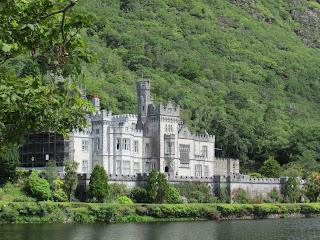LONDON: Act IV
March 7-9, 2017
IT WAS TIME to go to work.
The wanderer returned to the King's College, which was situated near the bank of the Thames. The wanderer had gone to the college the previous evening for her professor's guest lecture event and her companion's accompanying performance, which the wanderer had been helping her practice for the past few months. Afterwards, they all had had a dinner of overpriced pizza with a few of the professors at the college. She and her companion had been the only ones at the table not wearing glasses. The wanderer had felt rather like a child invited to eat at the grown-up table, but she nevertheless had enjoyed listening in on the scholarly, spectacled conversation.
For the next few days, it was the wanderer's turn to be scholarly (though still not spectacled). She and her companion were researching a British historian/writer/politician/military officer—quite a busy bee—named C.M. Woodhouse. The wanderer and her companion spent hours and hours going through folders in the King's College archive, flipping through old, yellowed documents with rusted paper clips; black-and-white photographs taken in Greece during WWII; tiny, handwritten journals; maps with lines and other small markings drawn onto them. The wanderer felt like quite the historian indeed.
DURING HER DAYS as a historian the wanderer also ambled through the National Gallery, where she traveled through the centuries, watching the evolution of art before her very eyes. She gazed at paintings by Monet, Seurat, van Gogh (whose famous "Sunflowers" was, based on her observations, the most popular piece in the museum) . . . Her eyes feasted.
Her stomach feasted as well, of course. The wanderer most often ate at her new favorite restaurant, Pret a Manger, which was full of delicious, natural, simple food (her favorite kind). But she also sampled some more exciting cuisine in the shapes of samosas, a falafel, a spinach pie from an outdoor market she randomly stumbled across, and, of course, fish and chips (more specifically, a kids' fish and chips, just the right proportion). Everything was delicious.
But the icing on the cake came in the form of bookshops. About a five minutes' walk from her hostel was a used bookshop called Skoob Books. Down a flight of stairs, down the rabbit hole, and one emerges into a world of books. Packed wooden bookshelves lined and walls and crammed together to form rows and rows of books. Nearly every available surface was covered in books. Books of all sizes and colors jutted and leaned and squeezed together, towers of books, walls of books: an organized book chaos. The wanderer dove right in.
On the opposite end of the bookshop spectrum was the National Theatre bookshop, which was small, neat, and tidy, books arranged in spit-spot displays, a tidy little reading nook in the corner, open space. The National Theatre bookshop, of course, offered a lovely variety of plays. The wanderer picked up a copy of Peter Pan and began reading joyously.
And then there were the chain bookshops Waterstones and Foyles. Waterstones, huge and multi-leveled, and Foyles, much smaller and more modest (at least the one on the South Bank), were filled with neatly ordered shelves and displays of books—brand-new books with their crisp unturned pages, books in every genre with their gorgeous British covers and artwork and why were the books here so much prettier than the books in America? The wanderer wished once again that she could take all the books back home with her. Instead, she limited herself to a few book souvenirs for her family—and a few for herself, because her favorite authors were British and she simply had to buy new copies of a couple of her favorite British books in Britain and, oh!, would you look at these miniature Penguin books, she simply must get a few of these, she's never seen anything like this in America . . .
Needless to say, the wanderer was a bibliophile, through and through.
THE WANDERER'S OWN two feet carried her throughout London. Across and back the Waterloo Bridge, from the British Museum to the National Theatre, from Trafalgar Square to Parliament Square. But Mother Nature smiled down on the wanderer and sent practically no rain, and so there was no trudging through puddles, splashing down streets, running through downpours. London was uncharacteristically dry, and the wanderer was grateful.
Step by step by step traveled the wanderer. In her wanderings she encountered scurrying pigeons, singing buskers, a wild fox. She met dashing Big Ben and walked beneath the colossal, watchful Eye.
Over the course of these few days, the wanderer witnessed plays galore: Love's Labours Lost, which was filled with rhymes and Shakespeare silliness; Travesties, which was witty and fast-paced and required one's full attention to keep up with; Othello, which brought her back to the beautiful candlelit Globe; and Twelfth Night at the ginormous National Theatre, which was undoubtedly the biggest production of all, with an amazing staircase set that rotated peeled back like an onion to reveal many other sets beneath, with pools that rose from the floor, with music and lights and dancing. It was a dazzling spectacle, a feast for the senses that took Shakespeare's centuries-old words and with them threw a party. It was old and new and unique and exciting.
It was London.
End of Act IV.
IT WAS TIME to go to work.
The wanderer returned to the King's College, which was situated near the bank of the Thames. The wanderer had gone to the college the previous evening for her professor's guest lecture event and her companion's accompanying performance, which the wanderer had been helping her practice for the past few months. Afterwards, they all had had a dinner of overpriced pizza with a few of the professors at the college. She and her companion had been the only ones at the table not wearing glasses. The wanderer had felt rather like a child invited to eat at the grown-up table, but she nevertheless had enjoyed listening in on the scholarly, spectacled conversation.
For the next few days, it was the wanderer's turn to be scholarly (though still not spectacled). She and her companion were researching a British historian/writer/politician/military officer—quite a busy bee—named C.M. Woodhouse. The wanderer and her companion spent hours and hours going through folders in the King's College archive, flipping through old, yellowed documents with rusted paper clips; black-and-white photographs taken in Greece during WWII; tiny, handwritten journals; maps with lines and other small markings drawn onto them. The wanderer felt like quite the historian indeed.
DURING HER DAYS as a historian the wanderer also ambled through the National Gallery, where she traveled through the centuries, watching the evolution of art before her very eyes. She gazed at paintings by Monet, Seurat, van Gogh (whose famous "Sunflowers" was, based on her observations, the most popular piece in the museum) . . . Her eyes feasted.
Her stomach feasted as well, of course. The wanderer most often ate at her new favorite restaurant, Pret a Manger, which was full of delicious, natural, simple food (her favorite kind). But she also sampled some more exciting cuisine in the shapes of samosas, a falafel, a spinach pie from an outdoor market she randomly stumbled across, and, of course, fish and chips (more specifically, a kids' fish and chips, just the right proportion). Everything was delicious.
But the icing on the cake came in the form of bookshops. About a five minutes' walk from her hostel was a used bookshop called Skoob Books. Down a flight of stairs, down the rabbit hole, and one emerges into a world of books. Packed wooden bookshelves lined and walls and crammed together to form rows and rows of books. Nearly every available surface was covered in books. Books of all sizes and colors jutted and leaned and squeezed together, towers of books, walls of books: an organized book chaos. The wanderer dove right in.
On the opposite end of the bookshop spectrum was the National Theatre bookshop, which was small, neat, and tidy, books arranged in spit-spot displays, a tidy little reading nook in the corner, open space. The National Theatre bookshop, of course, offered a lovely variety of plays. The wanderer picked up a copy of Peter Pan and began reading joyously.
And then there were the chain bookshops Waterstones and Foyles. Waterstones, huge and multi-leveled, and Foyles, much smaller and more modest (at least the one on the South Bank), were filled with neatly ordered shelves and displays of books—brand-new books with their crisp unturned pages, books in every genre with their gorgeous British covers and artwork and why were the books here so much prettier than the books in America? The wanderer wished once again that she could take all the books back home with her. Instead, she limited herself to a few book souvenirs for her family—and a few for herself, because her favorite authors were British and she simply had to buy new copies of a couple of her favorite British books in Britain and, oh!, would you look at these miniature Penguin books, she simply must get a few of these, she's never seen anything like this in America . . .
Needless to say, the wanderer was a bibliophile, through and through.
THE WANDERER'S OWN two feet carried her throughout London. Across and back the Waterloo Bridge, from the British Museum to the National Theatre, from Trafalgar Square to Parliament Square. But Mother Nature smiled down on the wanderer and sent practically no rain, and so there was no trudging through puddles, splashing down streets, running through downpours. London was uncharacteristically dry, and the wanderer was grateful.
Step by step by step traveled the wanderer. In her wanderings she encountered scurrying pigeons, singing buskers, a wild fox. She met dashing Big Ben and walked beneath the colossal, watchful Eye.
Over the course of these few days, the wanderer witnessed plays galore: Love's Labours Lost, which was filled with rhymes and Shakespeare silliness; Travesties, which was witty and fast-paced and required one's full attention to keep up with; Othello, which brought her back to the beautiful candlelit Globe; and Twelfth Night at the ginormous National Theatre, which was undoubtedly the biggest production of all, with an amazing staircase set that rotated peeled back like an onion to reveal many other sets beneath, with pools that rose from the floor, with music and lights and dancing. It was a dazzling spectacle, a feast for the senses that took Shakespeare's centuries-old words and with them threw a party. It was old and new and unique and exciting.
It was London.
End of Act IV.















*makes notes of all the restaurants and bookshops for when she eventually makes it to London* Still very much enjoying these accounts of your journeys!
ReplyDeleteI really hope you'll be able to visit London someday soon!
Delete